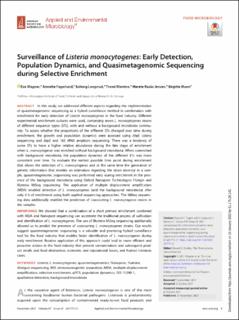| dc.contributor.author | Wagner, Eva | |
| dc.contributor.author | Fagerlund, Annette | |
| dc.contributor.author | Langsrud, Solveig | |
| dc.contributor.author | Møretrø, Trond | |
| dc.contributor.author | Jensen, Merete Rusås | |
| dc.contributor.author | Moen, Birgitte | |
| dc.date.accessioned | 2022-01-19T12:38:00Z | |
| dc.date.available | 2022-01-19T12:38:00Z | |
| dc.date.created | 2021-10-13T10:15:39Z | |
| dc.date.issued | 2021 | |
| dc.identifier.citation | Applied and Environmental Microbiology. 2021, 87 (24), 1-20. | |
| dc.identifier.issn | 0099-2240 | |
| dc.identifier.uri | https://hdl.handle.net/11250/2838263 | |
| dc.description.abstract | In this study, we addressed different aspects regarding the implementation of quasimetagenomic sequencing as a hybrid surveillance method in combination with enrichment for early detection of Listeria monocytogenes in the food industry. Different experimental enrichment cultures were used, comprising seven L. monocytogenes strains of different sequence types (STs), with and without a background microbiota community. To assess whether the proportions of the different STs changed over time during enrichment, the growth and population dynamics were assessed using dapE colony sequencing and dapE and 16S rRNA amplicon sequencing. There was a tendency of some STs to have a higher relative abundance during the late stage of enrichment when L. monocytogenes was enriched without background microbiota. When coenriched with background microbiota, the population dynamics of the different STs was more consistent over time. To evaluate the earliest possible time point during enrichment that allows the detection of L. monocytogenes and at the same time the generation of genetic information that enables an estimation regarding the strain diversity in a sample, quasimetagenomic sequencing was performed early during enrichment in the presence of the background microbiota using Oxford Nanopore Technologies Flongle and Illumina MiSeq sequencing. The application of multiple displacement amplification (MDA) enabled detection of L. monocytogenes (and the background microbiota) after only 4 h of enrichment using both applied sequencing approaches. The MiSeq sequencing data additionally enabled the prediction of cooccurring L. monocytogenes strains in the samples. | |
| dc.language.iso | eng | |
| dc.relation.uri | https://journals.asm.org/doi/10.1128/AEM.01774-21 | |
| dc.subject | Illumina | |
| dc.subject | Illumina | |
| dc.subject | Nanopore | |
| dc.subject | Nanopore | |
| dc.subject | Shotgun sequencing | |
| dc.subject | Shotgun sequencing | |
| dc.subject | Listeria monocytogenes | |
| dc.subject | Listeria monocytogenes | |
| dc.subject | Quasimetagenomics | |
| dc.subject | Quasimetagenomics | |
| dc.title | Surveillance of Listeria monocytogenes: Early detection, population dynamics and quasimetagenomic sequencing during selective enrichment | |
| dc.type | Peer reviewed | |
| dc.type | Journal article | |
| dc.description.version | publishedVersion | |
| dc.source.pagenumber | 1-20 | |
| dc.source.volume | 87 | |
| dc.source.journal | Applied and Environmental Microbiology | |
| dc.source.issue | 24 | |
| dc.identifier.doi | 10.1128/AEM.01774-21 | |
| dc.identifier.cristin | 1945513 | |
| dc.relation.project | Nofima AS: 202104 | |
| dc.relation.project | Norges forskningsråd: 314743 | |
| dc.relation.project | Norges forskningsråd: 294910 | |
| dc.relation.project | Nofima AS: 12635 | |
| cristin.ispublished | true | |
| cristin.fulltext | original | |
| cristin.qualitycode | 2 | |
